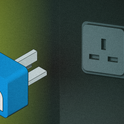Image of the month: the elephant in the womb
The media responded to Craig Venter’s unveiling of an “artificial cell” in late May with the hyperbole you’d expect. Other scientists grumbled at the hype—their general message (accurate, if a little churlish) was “not bad, but no big deal.” Like extra-syllabus questions at school, headline-grabbing developments like this are very effective at revealing what we don’t understand. Charlie Brooker in the Guardian was as funny as ever, but inadvertently revealed that geneticists have failed to communicate that there are no simple genetic instructions for “add two extra legs” or “omit appendix.” Alasdair Palmer in the Telegraph found himself forced to enter the 20th (some might say the 17th) century, crying: “What has happened to the mystery of life, the intangible, miraculous glory that we think is somehow its essence? It has disappeared. There are only molecules and the void.”
Venter is the founder of the US biotech company Celera, which previously raised data-ownership fears with its private project to sequence the human genome. One critic was John Sulston, the biologist who directed British contributions to the publicly-funded Human Genome Project. Now the two are clashing again, after Sulston argued on BBC Radio 4 that, in the wake of the synthetic cell, Venter’s company would be able to seize patents that “would give them control of all bioengineering in the future.” This is not a negligible concern, but the very artificiality of Venter’s bespoke bacterial genome seems to diminish it. There are many possible ways to reconfigure bacteria, and no one knows if his is the most promising.
And in all of this, why is so little interest shown in Venter’s team? The man knows how to attract money and publicity, but his canniest achievement was to attract good scientists. He would never have got this far without a stellar group, perhaps benefitting most from the expertise of Nobel laureate microbiologist Hamilton Smith, whose work on genome-snipping enzymes helped to make genetic biotechnology possible.
The slump’s silver lining
According to the European Environment Agency, the recession has a silver lining: it is partly responsible for a drop in greenhouse-gas emissions from the 27 EU member states. Emissions have been falling since 2003 for many reasons, but rising fuel prices and industrial slowdown accelerated the decline in 2008, and are expected to have done so even more in 2009. With EU emissions 11.3 per cent below 1990 levels at the end of 2008, the trend is halfway towards meeting the target figure of 20 per cent reduction unilaterally set by the EU. Germany has a much more ambitious national target of 40 per cent—closer to the level environmentalists believe is necessary to avoid serious climate change—and hopes that its aggressive pursuit of solar energy will help. This initiative is being observed closely in the US, where the department of energy is funding 46 Energy Frontier Research Centres, each at around $10-25m over five years, to develop renewable technologies.
Acupuncturing a myth
One of the main challenges for alternative therapies seeking scientific validation is that they come laden with tradition and ritual. Take a recent study purporting to offer a biochemical mechanism for acupuncture. It showed that mice, when treated in a traditional knee point to relieve inflammatory pain in the paw, had boosted levels of adenosine, a neuromodulator produced by the body for pain relief, and their discomfort was reduced significantly. The finding is persuasive and interesting, but does it shed much light on acupuncture? Acupuncturists insist that it matters precisely where the needles go—an issue that the mice researchers in New York did not properly discuss. And the theory of the flow of “qi,” or energy, along meridians in the body remains as remote as ever from conventional physiology. In the end, the treatment’s efficacy must be determined by clinical trials, which still struggle to identify a consistent effect beyond placebo.
The media responded to Craig Venter’s unveiling of an “artificial cell” in late May with the hyperbole you’d expect. Other scientists grumbled at the hype—their general message (accurate, if a little churlish) was “not bad, but no big deal.” Like extra-syllabus questions at school, headline-grabbing developments like this are very effective at revealing what we don’t understand. Charlie Brooker in the Guardian was as funny as ever, but inadvertently revealed that geneticists have failed to communicate that there are no simple genetic instructions for “add two extra legs” or “omit appendix.” Alasdair Palmer in the Telegraph found himself forced to enter the 20th (some might say the 17th) century, crying: “What has happened to the mystery of life, the intangible, miraculous glory that we think is somehow its essence? It has disappeared. There are only molecules and the void.”
Venter is the founder of the US biotech company Celera, which previously raised data-ownership fears with its private project to sequence the human genome. One critic was John Sulston, the biologist who directed British contributions to the publicly-funded Human Genome Project. Now the two are clashing again, after Sulston argued on BBC Radio 4 that, in the wake of the synthetic cell, Venter’s company would be able to seize patents that “would give them control of all bioengineering in the future.” This is not a negligible concern, but the very artificiality of Venter’s bespoke bacterial genome seems to diminish it. There are many possible ways to reconfigure bacteria, and no one knows if his is the most promising.
And in all of this, why is so little interest shown in Venter’s team? The man knows how to attract money and publicity, but his canniest achievement was to attract good scientists. He would never have got this far without a stellar group, perhaps benefitting most from the expertise of Nobel laureate microbiologist Hamilton Smith, whose work on genome-snipping enzymes helped to make genetic biotechnology possible.
The slump’s silver lining
According to the European Environment Agency, the recession has a silver lining: it is partly responsible for a drop in greenhouse-gas emissions from the 27 EU member states. Emissions have been falling since 2003 for many reasons, but rising fuel prices and industrial slowdown accelerated the decline in 2008, and are expected to have done so even more in 2009. With EU emissions 11.3 per cent below 1990 levels at the end of 2008, the trend is halfway towards meeting the target figure of 20 per cent reduction unilaterally set by the EU. Germany has a much more ambitious national target of 40 per cent—closer to the level environmentalists believe is necessary to avoid serious climate change—and hopes that its aggressive pursuit of solar energy will help. This initiative is being observed closely in the US, where the department of energy is funding 46 Energy Frontier Research Centres, each at around $10-25m over five years, to develop renewable technologies.
Acupuncturing a myth
One of the main challenges for alternative therapies seeking scientific validation is that they come laden with tradition and ritual. Take a recent study purporting to offer a biochemical mechanism for acupuncture. It showed that mice, when treated in a traditional knee point to relieve inflammatory pain in the paw, had boosted levels of adenosine, a neuromodulator produced by the body for pain relief, and their discomfort was reduced significantly. The finding is persuasive and interesting, but does it shed much light on acupuncture? Acupuncturists insist that it matters precisely where the needles go—an issue that the mice researchers in New York did not properly discuss. And the theory of the flow of “qi,” or energy, along meridians in the body remains as remote as ever from conventional physiology. In the end, the treatment’s efficacy must be determined by clinical trials, which still struggle to identify a consistent effect beyond placebo.












